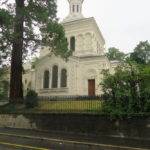La Collégiale of Neuchâtel is a medieval monument. The construction of the church began around 1190. A new construction phase included the building of the monastery, the extension of the nave and the west portal and the St Michael’s Chapel. The inauguration of the church took place in 1276. The southern tower was built around 1300, the second tower in the 19th century.

Until the beginning of the 13th century, the architecture followed the Romanesque tradition of the Upper Rhine. The Gothic style of the Burgundy and French-speaking Switzerland arrived afterwards.
The cathedral of Lausanne has inspired the builders as well. The church shows a similiar ensemble of sculpture and statues and anthropomorphic or zoomorphic figures.
The Collégiale and the castle still dominate the skyline of the city.
(Source and further information: www.neuchatelville.ch).




The reformer Guillaume Farel (1489-1565) in front of the church











